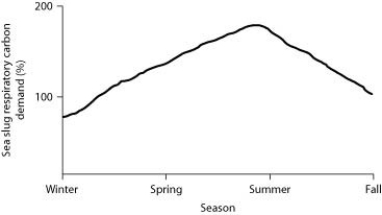Multiple Choice
Use the information and figure to answer the following question.
The sea slug Pteraeolidia ianthina can harbor living dinoflagellates (photosynthetic protists) in its skin. These endosymbiotic dinoflagellates reproduce quickly enough to maintain their populations. Low populations do not affect the sea slugs very much, but high populations (> 5 × 10⁵ cells/mg of sea slug protein) can promote sea slug survival.
Percent of sea slug respiratory carbon demand provided by indwelling dinoflagellates.
In the graph, the percent of the oxygen demand contributed by the dinoflagellates is greater than 100% during much of the year. What is the fate of this "excess" energy?
A) It is dispersed as "entropy" (disorder in the system) .
B) It is saved for producing offspring by the sea slug.
C) It is used to move around the sea bottom.
D) It is used in evaporative cooling by the sea slug.
Correct Answer:

Verified
Correct Answer:
Verified
Q7: Which of the following is most likely
Q21: All insects _.<br>A) undergo complete metamorphosis and
Q40: Use the following information and figures to
Q41: Healthy corals are brightly colored because they
Q42: Use the following information and figure to
Q45: Use the information and figure to answer
Q46: Use the information to answer the following
Q48: Use the following information and figures to
Q49: <img src="https://d2lvgg3v3hfg70.cloudfront.net/TB3075/.jpg" alt=" In Figure 33.8,
Q56: What would be the most direct effect